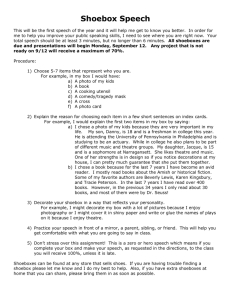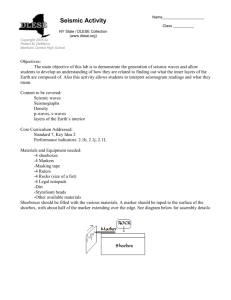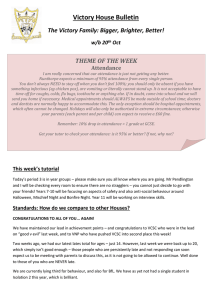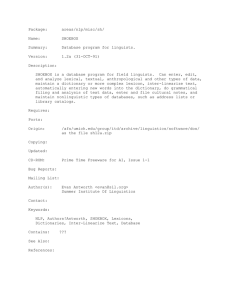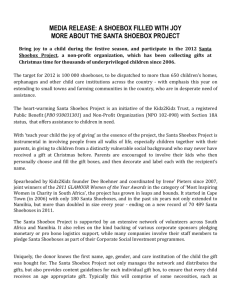SHOEBOX PROJECT
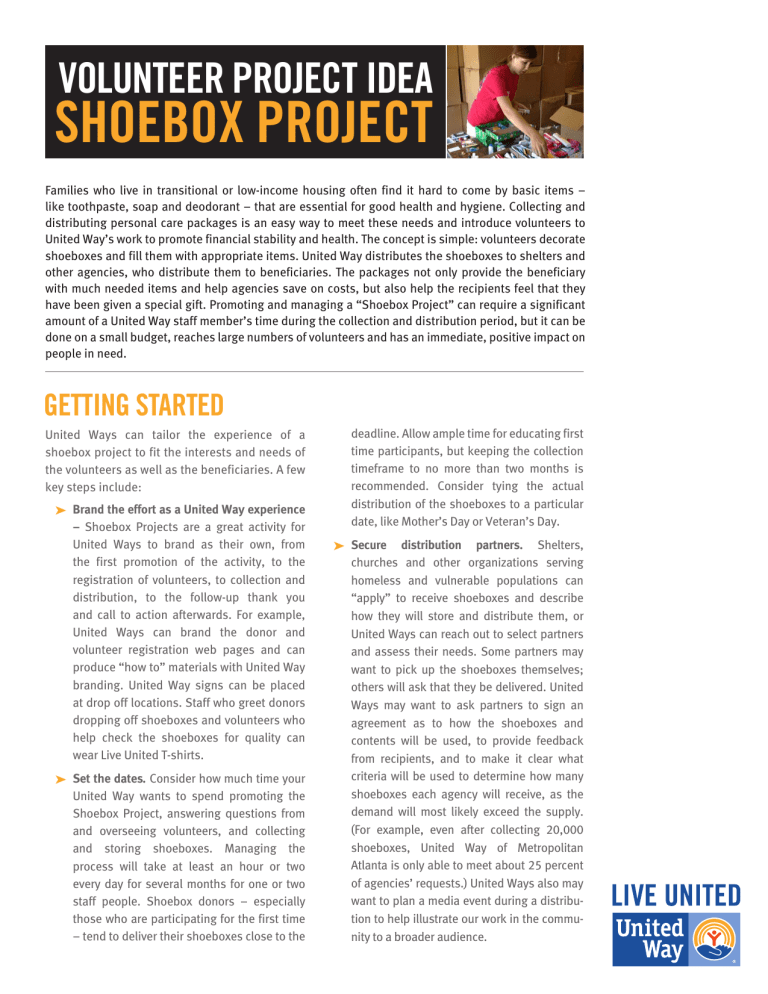
VOLUNTEER PROJECT IDEA
SHOEBOX PROJECT
Families who live in transitional or low-income housing often find it hard to come by basic items – like toothpaste, soap and deodorant – that are essential for good health and hygiene. Collecting and distributing personal care packages is an easy way to meet these needs and introduce volunteers to
United Way’s work to promote financial stability and health. The concept is simple: volunteers decorate shoeboxes and fill them with appropriate items. United Way distributes the shoeboxes to shelters and other agencies, who distribute them to beneficiaries. The packages not only provide the beneficiary with much needed items and help agencies save on costs, but also help the recipients feel that they have been given a special gift. Promoting and managing a “Shoebox Project” can require a significant amount of a United Way staff member’s time during the collection and distribution period, but it can be done on a small budget, reaches large numbers of volunteers and has an immediate, positive impact on people in need.
GETTING STARTED
United Ways can tailor the experience of a shoebox project to fit the interests and needs of the volunteers as well as the beneficiaries. A few key steps include:
➤
Brand the effort as a United Way experience
– Shoebox Projects are a great activity for
United Ways to brand as their own, from the first promotion of the activity, to the registration of volunteers, to collection and distribution, to the follow-up thank you and call to action afterwards. For example,
United Ways can brand the donor and volunteer registration web pages and can produce “how to” materials with United Way branding. United Way signs can be placed at drop off locations. Staff who greet donors dropping off shoeboxes and volunteers who help check the shoeboxes for quality can wear Live United T-shirts.
➤
Set the dates. Consider how much time your
United Way wants to spend promoting the
Shoebox Project, answering questions from and overseeing volunteers, and collecting and storing shoeboxes. Managing the process will take at least an hour or two every day for several months for one or two staff people. Shoebox donors – especially those who are participating for the first time
– tend to deliver their shoeboxes close to the deadline. Allow ample time for educating first time participants, but keeping the collection timeframe to no more than two months is recommended. Consider tying the actual distribution of the shoeboxes to a particular date, like Mother’s Day or Veteran’s Day.
➤ Secure distribution partners.
Shelters, churches and other organizations serving homeless and vulnerable populations can
“apply” to receive shoeboxes and describe how they will store and distribute them, or
United Ways can reach out to select partners and assess their needs. Some partners may want to pick up the shoeboxes themselves; others will ask that they be delivered. United
Ways may want to ask partners to sign an agreement as to how the shoeboxes and contents will be used, to provide feedback from recipients, and to make it clear what criteria will be used to determine how many shoeboxes each agency will receive, as the demand will most likely exceed the supply.
(For example, even after collecting 20,000 shoeboxes, United Way of Metropolitan
Atlanta is only able to meet about 25 percent of agencies’ requests.) United Ways also may want to plan a media event during a distribution to help illustrate our work in the community to a broader audience.
➤ Recruit shoebox donors and other volunteers.
Decorating and filling shoeboxes is a great activity for groups of volunteers, families and especially for companies that want to host on-site volunteer opportunities for employees. Creating informational and promotional materials suitable for a workplace as well as for volunteers who host a “shoebox party” on their own can help educate volunteers about the challenges the homeless face in your community, set the parameters for a shoebox decorating contest and help volunteers feel connected to a larger effort. Fliers could indicate a list of needed items and items that cannot be used, e.g., medicine, food and used or opened items. Shoebox donors also should be instructed that shoeboxes must be able to be opened for safety inspections.
In addition to asking for donations of decorated, filled shoeboxes, United Ways can ask for donations of toiletry items from hotels or from smaller groups that may not want to host a shoebox decorating event.
United Way can recruit its own volunteers to assemble and decorate shoeboxes, as well as to help sort, inspect, allocate and distribute them. All volunteers should be thanked, informed of the numbers of shoeboxes distributed and invited to engage in United
Way’s work again.
➤ Secure collection points and delivery and storage services.
United Ways may want to establish a thres hold (e.g., 150 shoeboxes) for picking up shoeboxes from donors, and will need to establish collection points for donations lower than the threshold. United
Way offices, community centers and other central locations can serve as collection points. United Ways could create a flyer indicating the hours, address, phone number, and point of contact for each collection point, and a way for donors to let United Way know that they are planning on dropping off shoeboxes.
It can be surprising how many shoeboxes are donated; e.g., United Way of Metropolitan
Atlanta received 1,000 shoeboxes the first year of its program, and more than 20,000 were donated six years later. Therefore it is essential to have a delivery partner, professional movers or volunteers ready to pick up shoeboxes from collection points and from donors who create large numbers of shoeboxes. United Ways should also solicit donations of large moving boxes which will make transporting and counting the shoeboxes easier. Finally, warehouse or empty office space can be donated to store the shoeboxes until it is time to inspect and distribute them.
SAMPLE SHOEBOX ITEMS
Travel size shampoo
Deodorant
Travel size soap
Toothbrush and toothpaste
Nonalcoholic mouthwash
Travel size lotion
Hair comb/brush
Sunscreen
Lip balm
Adhesive bandages
Hand towels
Antibiotic Ointment
Socks
Tampons
Panty liners
Travel size water bottles
Rain ponchos
Resealable zipper storage bags
Prepaid phone cards
PROJECT EXAMPLES
United Way of Metropolitan Atlanta
In 2012, United Way of Metropolitan Atlanta collected more than 20,000 decorated shoeboxes from March 1– May 1, and nearly 100 agencies throughout the region distributed them to homeless women and children in celebration of Mother’s Day. Altogether, more than 72,000 shoeboxes have been distributed since the annual
Shoebox Project began in 2007. Today, United Way invites companies and the entire community to participate and holds a contest for the bestdecorated shoebox. The 2012 winner received two round-trip tickets on Delta Air Lines.
The effort begins in the fall, when United Way of
Metropolitan Atlanta secures unsold warehouse space for free and confirms the participation of volunteer FedEx drivers for picking up and delivering shoeboxes. The transport of shoeboxes has grown to be a massive undertaking, driven through personal ties, rather than a formal, company-wide partnership. In 2012, Atlanta-area
FedEx drivers picked up nearly 11,000 shoeboxes from 38 locations.
The marketing team comes up with promotional tools such as: emails, flyers, a poster, web page, etc. Volunteer recruitment is targeted to corporate donors, who like providing employees with an onsite service project. Some employees get organizations they are involved with to donate shoeboxes as well. With radio and television media sponsors, the broader community knows about the Shoebox Project and also participates.
Donors drop off their filled shoeboxes at one of 15 locations in the 13 county region that United Way serves, or if they have more than 150 shoeboxes, they can request a FedEx pick up. Upon request,
United Way provides a tax deduction letter valuing each box at $15.00. Regardless of the length of time that shoeboxes are accepted, over the years donors have tended to drop off most shoeboxes as the deadline approaches.
FedEx delivers shoeboxes to the warehouse and volunteers inspect the contents, removing or adding items as appropriate. Volunteers then put 25 shoeboxes in donated moving boxes, and depending on agency requests, may assemble boxes that are all for children or all for women.
United Way of Metropolitan Atlanta also receives bags of supplies and volunteers assemble and decorate empty shoeboxes donated by Target.
Shoebox donors can enter the competition by providing United Way with a photo of their shoebox via Facebook or Twitter. United Way staff chooses the best entries based on the photo and volunteers inspecting the shoeboxes look for them and set them aside. United Way holds a fun event for volunteer judges to select the winner.
Project costs are extremely low. Expenses might include water and snacks for volunteers, extra supplies to bring to parties in case a company might not have enough wrapping paper, ribbon, etc., tables and chairs for the warehouse, and some posters for the drop off locations. The director of volunteerism spends about 25 percent of her time during the peak of the project, with a volunteer coordinator spending 90 percent of her time. United Way conducts other collections throughout the year, including a school supply drive and a coat drive, but those events do not require the same manual effort and time commitment as the Shoebox Project. For example, even though United Way publishes hours for donors to drop off shoeboxes, they tend to bring them at other times.
United Way of Metropolitan Atlanta wants the Shoebox Project to be an entry point for volunteers to United Way. United Way sent an email after Mother’s Day thanking the volunteers, announcing the winner and the number of shoeboxes donated, and providing other ways to get involved in helping the homeless through
United Way.
Contact: Lea Rolfes, Director, Volunteerism, United Way of
Metropolitan Atlanta
We are soooooo veryyyyyy PRIVILEGED to be one of the hundreds of recipients of the United Way of
Metropolitan Atlanta annual Shoebox Project…This year, we received over 4,000 items of toiletries, socks, emergency supplies for the youth we serve in the shelter and on the street! We have saved thousands of dollars and the items are wonderful…The kids really appreciate such gifts in the nicely decorated shoeboxes and some even have notes of encouragement! Thank You United Way of Metro Atlanta…. your team is AWESOME!
YOUNG PEOPLE MATTER
United Way of the National Capital Area
United Way of the National Capital Area, which serves the greater Washington, D.C. metropolitan area, launched its first Shoebox Project in 2012 and collected about 2,000 shoeboxes filled with basic needs or emergency preparedness items. Volunteers distributed the shoeboxes on the National Day of Action (June 21) to member nonprofit organizations serving veterans, the elderly and the homeless.
Office Movers provided free pick up of 150 boxes or more and delivered them to a large Salvation
Army office for inspection and storage. Clothing retailer TJ Maxx donated empty shoeboxes and local schoolchildren decorated them. United
Way also reserved a conference room at the
Salvation Army to host volunteer events twice a week. Corporate and other volunteers helped sort donated toiletries, check filled shoeboxes to make sure all the included items are safe (e.g., only alcohol-free mouth wash, no sewing kits, etc.), pack empty shoeboxes with donated items, and wrap undecorated boxes.
KEYS for the Homeless stewards in-kind contributions from the local hospitality industry to organizations serving people living in poverty and along with United Way of Metropolitan Atlanta, was an important partner for the Shoebox Project. In addition to having conducted shoebox projects in the past, KEYS knew what various shelters needed, such as emergency preparedness items, and facilitated donations from area hotels.
Shoebox donors could compete in a contest for the best-decorated box by sending a photo to
United Way via Facebook or Twitter. The United
Way Emerging Leaders Council chose the top five entries and speakers from their quarterly leadership series decided on the top three best decorated shoeboxes. Prizes included a night at a local hotel, theatre tickets, and an e-reader.
United Way of the National Capital Area conducted tailored outreach to its regional councils, schools, and most engaged companies (but not necessarily the biggest contributors), and also sent an email about the Shoebox Project to its list of more than 40,000 people. The marketing department developed tools to help employee campaign coordinators and United Way staff spread the word about the project throughout the community.
Items included fliers in English and Spanish, customizable party poster, thermometer poster, donation bin poster, email signature block, an information toolkit and advertisements, including print and web (Google Ads and Facebook). A new webpage directed shoebox donors to register or to make a $25 contribution to “purchase” a pre-filled shoebox to donate. On Sundays in May, United
Way set up a special collection site at a farmer’s market and also handed out empty shoeboxes with information about how to participate.
United Way found that the Shoebox Project was a great way to engage donors, especially affinity groups, and to promote United Way and its work via workplace partners. For example, United
Way’s Emerging Leaders Society partnered with other local young professional groups in the area to collect toiletries during their events. The Fairmont Hotel held a competition among its employees. Another partner, the Federal Emergency
Management Agency, ran an internal drive and held a shoebox drive/decorating party during the agency’s Bring Your Child to Work Day.
Distribution of the shoeboxes on the national
United Way Day of Action provided another opportunity for volunteers to get involved.
Volunteers took shoeboxes to United Way’s member nonprofit organizations and engaged in volunteer work there as well. Other volunteers finished decorating, sorting, and packing shoeboxes for members to pick up and helped load them into cars. United Way also provided
KEYS for the Homeless with some shoeboxes to deliver to clients and nonprofits. The Day of Action concluded with a reception and fair for member nonprofits, donors, and volunteers to come together around the Shoebox Project.
For more information contact:
The project took about six months from initial planning to the distribution of shoeboxes to the member nonprofit organizations. Web and marketing planning began in late December and the first email announcing the Shoebox Project was sent in March. As with many first time projects it took time for the idea to catch hold and to answer questions from interested volunteers. Three
United Way staff members have worked on the project, with one staff member spending about 40 percent of her time on the Shoebox Project while the collection was underway (April 1 – June 1).
Mei Cobb
Vice President
Volunteer and
Employee Engagement
United Way Worldwide mei.cobb@unitedway.org
Contact: Mary Jo Bean, Major Gifts Coordinator, United Way of the National Capital Area
